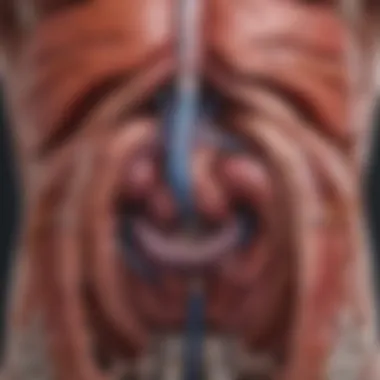Understanding Human Liver Problems: Causes and Treatments


Intro
The human liver, a marvel of nature, is often referred to as the body's biochemical powerhouse. Sitting snugly in the upper right quadrant of the abdominal cavity, this vital organ orchestrates numerous processes critical for sustaining life. From metabolizing nutrients to detoxifying harmful substances, the liver is equally celebrated and challenged. Unfortunately, it becomes a victim of various conditions that can lead to significant health complications if left unchecked.
Understanding liver problems isn't merely an academic pursuit; it impacts the health of millions worldwide. The complexity surrounding liver diseases—from hepatitis to cirrhosis—demands a nuanced approach. Each condition has its own set of causes, symptoms, and treatment options, which requires a detailed exploration.
Research Highlights
Overview of Key Findings
In dissecting liver health, researchers have uncovered several vital insights:
- Role of lifestyle choices: Factors such as obesity and excessive alcohol consumption significantly influence liver function and health.
- Viral infections: Hepatitis B and C are leading causes of chronic liver disease, with increased global prevalence.
- Emerging conditions: Non-alcoholic fatty liver disease is on the rise, particularly among younger populations.
These findings underscore the pressing need for awareness around liver health, preventive care, and treatment options.
Significance of the Research
The importance of research in liver problems cannot be overstated. By recognizing the early signs and symptoms, individuals can take proactive measures, thereby potentially avoiding severe complications. Moreover, advancements in treatment methods, including antiviral therapies and liver transplants, have dramatically improved outcomes for many patients.
"Timely intervention in liver-related diseases is not just beneficial but essential for long-term health."
Current Trends in Liver Health
Staying informed about current trends is crucial. Awareness campaigns on liver health encourage regular screenings, vaccination against hepatitis, and lifestyle modifications.
The resonance of liver disorders emphasizes the need for an in-depth understanding. By exploring causes, symptoms, treatment options, and preventive measures, we elevate the conversation surrounding liver health and empower individuals to take charge of their well-being.
Preamble to Liver Function
Understanding the liver's functions is essential in grasping the broader context of liver issues. The liver, often called the body's biochemical powerhouse, has a multitude of roles that are integral for maintaining overall health. The importance of this section is underscored by the fact that liver problems can disrupt its vital functions, leading to various health complications.
Overview of Liver Anatomy
The human liver is a large, reddish-brown organ located mainly in the upper right abdomen. It is divided into two main lobes, each with its own unique structure. The lobes consist of tiny functional units called lobules, which are where the liver performs its many functions. Comprised of specialized cells called hepatocytes, the liver also contains a network of blood vessels, bile ducts, and supporting connective tissues. This complex anatomy allows the liver to process nutrients, detoxify substances, and produce important biochemicals like bile.
Key Functions of the Liver
The liver has four primary functions that are crucial for overall health, which include metabolism, bile production, detoxification, and storage of nutrients. It's this multifaceted role that makes the liver both remarkable and susceptible to various disorders.
Metabolism
Metabolism in the liver governs how the body converts food into energy. This process includes both catabolic reactions—breaking down molecules for energy—and anabolic reactions, where energy is used to create necessary compounds. The liver efficiently regulates blood sugar levels by converting excess glucose into glycogen, which can be stored for later use. A key characteristic of liver metabolism is its dynamic ability to adapt based on nutritional status and energy needs. It's considered a beneficial focal point in understanding liver health as it impacts energy balance and nutrient processing. However, unhealthy lifestyle choices like poor diet and lack of exercise can disrupt this metabolic harmony, leading to conditions like fatty liver disease.
Bile Production
Bile production is another critical function of the liver. Bile is a thick fluid that helps in digesting fats and is released into the small intestine. The liver produces bile continuously, and this is a key characteristic because it aids in the emulsification of dietary fats, making them easier for digestive enzymes to break down. This function is important in understanding digestive health and the role of dietary fats. However, issues like the formation of gallstones can arise when bile becomes imbalanced, causing digestive problems.
Detoxification
Detoxification is where the liver truly shines as a guardian of the body. Its ability to filter blood and remove toxins, drugs, and waste products is vital for sustaining health. The liver metabolizes these harmful substances into less toxic forms, which can then be excreted from the body. This function is beneficial because it directly influences overall toxicity levels and health outcomes. However, excessive alcohol consumption or exposure to environmental toxins can overwhelm the liver's capacity to detoxify, leading to serious health issues.
Storage of Nutrients
The liver serves as a reservoir for essential vitamins and minerals, helping maintain balanced nutrient levels in the body. It stores nutrients like vitamins A, D, E, K, and various B vitamins, as well as iron and copper. This unique feature supports the body's needs during periods of fasting or increased energy demands. The storage of nutrients is crucial as it provides a buffer to the body’s nutritional needs and dictates metabolic responses. Yet, storage disorders can occur, where excess nutrients lead to toxicity or deficiency syndromes, pointing toward the liver’s pivotal role in maintaining homeostasis.
In summary, the liver's diverse functions—from metabolism to detoxification—highlight its significance in overall health and the impact that liver problems can have on the body.
Common Liver Problems
Understanding common liver problems is vital for grasping how various factors can deteriorate hepatic function and overall health. The liver, being a central hub for metabolizing nutrients and detoxifying harmful substances, is susceptible to multiple pathologies. Recognizing these problems can lead to early intervention, which is crucial in mitigating serious complications down the line. The most prevalent conditions affecting the liver include hepatitis, cirrhosis, and fatty liver diseases. Each of these categories encompasses diverse causes, symptoms, and potential treatments.
Hepatitis: Types and Causes
Viral Hepatitis
Viral hepatitis is particularly significant due to its global impact. It is primarily caused by infections from different viruses including hepatitis A, B, and C. A key characteristic of viral hepatitis is its contagious nature, which makes understanding its transmission critical. It offers an opportunity for public health campaigns to educate populations about prevention—particularly vaccinations for hepatitis A and B.
The unique feature of viral hepatitis is how it can become chronic, especially with hepatitis B and C, often leading to liver cirrhosis or even cancer. The implications are significant, making it a crucial point of discussion in this article as it underscores the need for awareness and preventive measures to safeguard liver health.
Alcoholic Hepatitis
Alcoholic hepatitis arises from excessive alcohol consumption. This type of hepatitis serves as a stark reminder of lifestyle choices impacting liver health. Its defining characteristic is the liver's inflammatory response to alcohol, which can range from mild to severe. This presents a clear pathway for prevention—eliminating or reducing alcohol intake can drastically lower the risk of developing this condition.
One unique aspect of alcoholic hepatitis is its potential reversibility; if detected early, changes in diet and lifestyle can restore liver health to some degree. However, the downside is that it often remains undiagnosed until significant damage has occurred, making this condition crucial for timely discussions in our exploration of liver health.
Autoimmune Hepatitis
Autoimmune hepatitis is less common but quite significant, as it involves the immune system mistakenly attacking liver cells. The key characteristic lies in its unpredictability, as it can affect anyone at any age, often occurring in individuals with other autoimmune disorders. This makes understanding autoimmune hepatitis vital for identifying patients who might be at risk.


One unique feature is that it typically presents with recurrent episodes of liver inflammation, which, if left unchecked, can lead to severe complications. The article highlights autoimmune hepatitis to stress the importance of recognizing less common liver diseases that may require specific diagnostic and treatment strategies.
Cirrhosis: Pathophysiology and Consequences
Progression of Liver Damage
The progression of liver damage is a fundamental aspect to understand in the context of cirrhosis. This process can stem from various causes, such as chronic viral infections, long-term alcohol abuse, and even fatty liver diseases. The key characteristic of this progression is its gradual nature; patients may feel fine until a significant amount of liver function has been lost. Raising awareness about how cirrhosis develops is necessary for early detection and intervention, as timely management can improve prognosis.
The unique feature here is that cirrhosis often acts as a final common pathway for many liver diseases, making it critical for discussions around liver health. Recognizing symptoms and risk factors can help individuals seek medical advice sooner rather than later.
Symptoms and Diagnosis
When examining symptoms and diagnosis related to cirrhosis, it is essential to note that they often do not manifest until late in the disease. Common symptoms include jaundice, fatigue, and swelling in the legs. The importance of thorough, regular medical check-ups becomes evident, as early symptoms can be vague and easily overlooked. Incorporating routine blood tests can provide essential insights into liver function and health.
The unique aspect of this condition is that often, the diagnosis is made incidentally during evaluations for unrelated complaints. This makes continuous education and awareness critical to improving detection and treatment outcomes.
Complications of Cirrhosis
Understanding the complications of cirrhosis is crucial for appreciating the seriousness of advanced liver disease. Complications can range from ascites to hepatic encephalopathy, and the key point here is their preventability through early management of liver diseases. Each complication bears significant morbidity; thus, this topic is highly relevant to this article.
One unique feature is the multitude of complications that can arise—each presenting its challenges in terms of treatment and management. For example, hepatic encephalopathy can severely impair cognitive function, posing additional healthcare challenges. This highlights the need for comprehensive care strategies that encompass not just the liver but the patient as a whole.
Fatty Liver Disease
Fatty liver disease constitutes a significant portion of liver-related health issues today. As our lifestyles change and health awareness evolves, this condition has come to the forefront of discussions about liver health. It is critical because it serves as an indicator of broader metabolic disturbances, often tied to dietary habits, exercise patterns, and overall health. Understanding fatty liver disease fosters a comprehensive view of how modern lifestyles can lead to severe health consequences. It also highlights the importance of timely interventions, making prevention an integral focus for ongoing public health education.
Non-Alcoholic Fatty Liver Disease (NAFLD)
Risk Factors
The risk factors associated with non-alcoholic fatty liver disease are multifaceted and can vary significantly from person to person. Chief among these are obesity and diabetes. Excessive fat accumulation in the liver often springs from weight gain, which is a hallmark of many metabolic conditions. According to studies, as body's fat percentage rises, the likelihood of NAFLD spikes. Sedentary lifestyles, poor dietary habits, and other comorbidity factors also play a notable role in an individual’s health trajectory. Recognizing these risk factors can serve as a wake-up call; by identifying them, one can better manage or even avert the onset of the disease.
The key characteristic of discussing risk factors is understanding the individual's lifestyle choices. This makes it a beneficial choice for this article, as it underscores how proactive measures can mitigate potential liver damage. Notably, while genetic predispositions matter, lifestyle habits often tip the scales toward health or illness.
Diagnosis
When it comes to diagnosis, recognizing fatty liver disease early can make a significant difference in treatment outcomes. Diagnostic methods often include liver function tests, imaging studies, and sometimes biopsies. What stands out about these procedures is that many are non-invasive and can be tailored based on the individual's risk profile and symptoms. For instance, ultrasound evaluations are commonly used due to their accessibility and effectiveness.
A significant benefit of early diagnosis is that it may prevent progression to more severe liver disease. The unique feature here is that many people are asymptomatic, meaning they could harbor the condition without being aware. This emphasizes the need for regular check-ups, particularly for high-risk individuals, making timely diagnosis a crucial theme in this article.
Management Strategies
As for management strategies, they revolve primarily around lifestyle changes, with diet and exercise taking center stage. Integrating a balanced diet rich in fruits, vegetables, and whole grains can help reduce liver fat levels effectively. Additionally, physical activity plays a fundamental role, as even modest weight loss can markedly improve liver health and reduce the burden of the disease.
The key characteristic of management strategies is their accessibility; most individuals can initiate changes without requiring specialized medical interventions. This starkly contrasts with many chronic health conditions that necessitate ongoing medications or treatments. Flexibility in choosing one’s approach to management may also appeal to those concerned with the challenges associated with more invasive treatments. However, this self-directed approach can be both an advantage and a disadvantage, as some may find it hard to maintain lifestyle changes without medical support or guidance.
Alcoholic Fatty Liver Disease
Etiology
The etiology of alcoholic fatty liver disease is largely centered on excessive alcohol consumption. Alcohol, when processed by the liver, can cause fatty buildup and cellular damage, which ultimately leads to inflammation and scarring if not addressed. Understanding this aspect is imperative for educating individuals about the repercussions of heavy drinking. Crucially, this topic delineates a clear path for prevention – cutting down on alcohol may avert or reverse progression towards more severe liver damage.
What makes this discussion interesting is the dual focus on alcohol intake and lifestyle factors such as diet and exercise, indicating that multiple avenues can be leveraged for intervention. Awareness about these factors can prompt individuals to evaluate their consumption habits, providing a practical approach to dealing with liver health and emphasizing personal responsibility and choice.
Clinical Features
The clinical features of alcoholic fatty liver disease often appear insidiously, making them hard to pinpoint until the condition becomes more severe. Symptoms like fatigue, abdominal discomfort, and weight loss might seem benign at first, but they serve as red flags indicating that one’s liver may be struggling under the burden of alcohol. This subtlety in presentation is a key characteristic of the disease, as many individuals may dismiss early signs, thinking they’re merely a sign of aging or stress.
Highlighting clinical features is pivotal for this article because it underscores the necessity of awareness; individuals need to understand these signs to seek medical advice promptly. This can be the difference between a minor adjustment in lifestyle and a more serious health intervention.
Preventive Measures
Finally, preventive measures against alcoholic fatty liver disease must focus on educational programs and public awareness campaigns promoting responsible drinking. Emphasizing moderation is critical, as it can greatly reduce the incidence of fatty liver disease and the associated long-term health risks. Programs may also include counseling services or support groups aimed at reducing alcohol dependency, which can be essential for at-risk populations.
The key characteristic here lies in the comprehension of collective responsibility. By fostering awareness and providing resources, communities can better support individuals in making informed choices. This discussion helps reinforce the message that while liver disease can stem from an individual’s choices, understanding the risks collectively positions society to engage in protective measures against alcohol-related liver problems.
Liver Cancer: Understanding Risk Factors
Liver cancer is an alarming health concern, often overshadowed by other forms of cancer. Understanding the risk factors associated with liver cancer is crucial for both prevention and early diagnosis. Awareness of these factors can help in identifying individuals at increased risk, leading to timely medical interventions. The complexity of liver cancer itself underlines the need for ongoing research and education in this vital area of health.
Types of Liver Cancer
Hepatocellular Carcinoma
Hepatocellular carcinoma is the most prevalent type of liver cancer, making up a staggering majority of diagnosed cases globally. This particular cancer often arises in individuals with chronic liver diseases, such as cirrhosis, where the liver tissue suffers prolonged damage and regeneration. The key characteristic of hepatocellular carcinoma is its insidious onset, often only detected in advanced stages. It serves as a critical focus for this exploration due to its ties with both hepatitis infections and lifestyle factors like alcohol consumption and obesity.
Unique to hepatocellular carcinoma is its multifaceted nature, often presenting with vague symptoms such as weight loss and abdominal discomfort. These challenges complicate early detection, necessitating comprehensive screening for high-risk individuals.
Cholangiocarcinoma
Cholangiocarcinoma, or bile duct cancer, is another serious type of liver cancer that originates in the bile ducts. Unlike hepatocellular carcinoma, it is less common but still poses significant health risks, especially for those with liver diseases or certain medical conditions like primary sclerosing cholangitis. This type exhibits a vital characteristic: its propensity to metastasize quickly, which demands swift diagnostic action. Cholangiocarcinoma makes for a compelling addition to this article due to its distinct pathophysiology and treatment strategies that differ from those used for hepatocellular carcinoma. Its unique feature lies in its varied presentations, which can lead to delayed diagnosis and poor prognosis.


Liver Metastases
Liver metastases refer to the spread of cancer from other organs to the liver, highlighting the liver's role as a common site for metastatic disease. The key aspect of liver metastases is that they usually indicate advanced cancer, making this a critical area of focus in understanding overall cancer risk. By examining liver metastases, we gain insight into how various cancers can compromise liver function and health. The unique feature of liver metastases is that they often reflect systemic cancer progression rather than originating from the liver itself. This complexity presents both advantages and disadvantages in treatment, as it may require addressing the primary cancer as well as the liver involvement.
Symptoms and Diagnostic Approaches
Recognizing the symptoms related to liver cancer is vital for early diagnosis. Typically, patients may experience symptoms such as jaundice, unexplained weight loss, and abdominal swelling. Understanding these early warning signs can greatly enhance outcomes for individuals at risk.
In terms of diagnostic approaches, several methods are employed including imaging techniques like ultrasound and MRI, alongside biopsies for definitive diagnosis. Lab tests measuring liver function also play a role in understanding the overall health of the liver. Integrating public awareness campaigns can help in promoting understanding of these symptoms and the importance of regular check-ups for those at risk.
"Understanding liver cancer's risk factors enables proactive measures, timely intervention, and ultimately, improved patient outcomes."
Through comprehensive examination of liver cancer and its various forms, it’s evident that the topic deserves thorough investigation and understanding as it plays a critical role in public health.
Diagnosis of Liver Diseases
Diagnosing liver diseases presents a remarkable blend of techniques from traditional to modern, requiring a thorough understanding of liver function and pathology. It's not just about spotting maladies but ensuring timely intervention — which is crucial for effective treatment. A late diagnosis can mean more severe complications. Therefore, healthcare professionals prioritize early detection to curb the progression of liver disorders.
When discussing liver diseases like hepatitis, cirrhosis, or fatty liver disease, diagnostic tests provide vital insights into the health of an individual's liver. They serve as the bridge linking symptoms with an accurate diagnosis. In a world where knowledge and swift action increase the odds of recovery, these techniques become essential.
Common Diagnostic Tests
Liver Function Tests
Liver function tests are an essential tool in assessing the liver’s ability to perform its numerous vital functions. This series of blood tests checks for levels of enzymes, proteins, and substances that the liver regulates or produces.
Key characteristic: One of the significant aspects of these tests is the enzyme aminotransferase, which indicates liver cell damage. When liver cells are injured, these enzymes leak into the bloodstream, making it easier to identify a potential problem.
Advantages: These tests are relatively simple and non-invasive, making them a go-to for initial evaluations. Healthcare providers often rely on these results to gauge the severity of liver disease, warranting further investigation if necessary. However, they can't provide a definitive diagnosis on their own; instead, they indicate where further scrutiny is warranted.
Imaging Techniques
Imaging techniques encompass various methods, including ultrasound, MRI, and CT scans, to visualize the liver's structure. They play a significant role in determining not just the presence of disease but also the extent of liver damage.
Key characteristic: Unlike blood tests, imaging can show physical changes in the liver’s anatomy, aiding in identifying tumors, cirrhosis, or fatty liver.
Advantages: Non-invasive and relatively quick, imaging techniques give doctors immediate insights. However, these scans sometimes may not detect minor inflammatory changes, meaning that while they are essential, they can miss nuances that lead to severe liver ailments.
Liver Biopsy
Liver biopsy stands apart as a direct approach to examining liver tissue. By obtaining a small sample of liver tissue, doctors can identify diseases such as hepatitis, cirrhosis, or liver cancer with high precision.
Key characteristic: The biopsy can provide the most definitive diagnosis, showing not only the presence of disease but also its severity and type.
Advantages: The high accuracy of this method allows healthcare professionals to formulate targeted treatment plans. On the flip side, it’s an invasive procedure that carries risks like bleeding or infection, which necessitates careful consideration before proceeding.
Role of Genetic Testing
Genetic testing has emerged as a significant player in diagnosing liver disorders, especially those with hereditary components, like Wilson's disease or hemochromatosis. Genetics provides a deeper understanding of one's risks and potential disease pathways. By identifying specific mutations, healthcare providers can tailor prevention and treatment strategies predisposed to liver conditions. This not only aids in the management of existing diseases but also informs family members about potential risks, allowing them to pursue proactive measures for their health.
Treatment Options for Liver Disorders
In navigating the complex landscape of liver disorders, identifying effective treatment options is paramount. Treatment strategies can range broadly from pharmacological interventions to surgical options, influencing not just the recovery of liver function, but the overall well-being of individuals affected by these diseases. It’s essential to tailor treatment plans according to the specific condition at hand, considering the patient's overall health, the severity of the liver disease, and potential complications that may arise. A thorough understanding of treatment modalities helps in empowering patients to take charge of their liver health while also preventing further complications.
Pharmacological Interventions
Antiviral Treatments for Hepatitis
When discussing antiviral treatments for hepatitis, we focus on their ability to combat viral infections effectively. These treatments aim to reduce the viral load in the liver, which is crucial in managing chronic hepatic infections. A standout characteristic of antiviral therapies is their variety, with options varying from pegylated interferon to nucleos(t)ide analogs, each having its own usage scenario. The benefit of these treatments lies in their potential to not only reduce symptoms but also improve liver function over time. For instance, direct-acting antivirals can achieve high cure rates for hepatitis C, making them a favorable consideration.
However, these treatments come with a unique downside, such as side effects that range from mild to severe. Close monitoring during treatment is often necessary, underlining the importance of professional guidance.
Medications for Cirrhosis
Medications geared towards managing cirrhosis primarily focus on alleviating symptoms and slowing disease progression. Diuretics, for instance, are commonly prescribed to manage fluid retention, while beta-blockers may help in reducing portal hypertension, a dangerous condition associated with cirrhosis. The key characteristic of these medications is their ability to minimize complications linked to liver dysfunction.
They provide significant benefits, like improving quality of life for patients, but there are notable considerations. The effectiveness often hinges on the stage of cirrhosis and underlying causes, requiring ongoing adjustments to medication regimens. It’s also critical to engage in regular health assessments to preemptively catch any potential side effects or complications.
Management of Fatty Liver
Fatty liver management encompasses a broad approach, predominantly focusing on lifestyle modifications and addressing underlying causes such as obesity or diabetes. Though currently, no specific medication is approved for non-alcoholic fatty liver disease (NAFLD), workarounds exist, such as the use of vitamin E or pioglitazone in select patients. The uniqueness of managing fatty liver lies in its non-invasive nature; instead of pharmaceuticals, physicians often encourage dietary changes and physical activity as primary strategies.
While these changes can significantly impact health outcomes, adherence can be a tricky hill to climb. The long-term benefits of management heavily depend on sustained lifestyle modifications, requiring both patient discipline and continuous education on liver health.
Surgical Interventions
Liver Transplantation
Liver transplantation is a critical option for patients whose liver is severely damaged and no longer functions adequately. The primary advantage of this procedure is the potential to restore normal liver function in patients facing life-threatening liver diseases. It’s considered a lifeline for individuals with conditions like cirrhosis and acute liver failure.


A unique aspect of transplantation is the complexity involved: matching organ donors with recipients, post-operative care, and managing immunosuppressive medications to prevent rejection. While transplantation can dramatically improve survival rates, it’s not without challenges, including ongoing medical supervision and the risk of transplant rejection.
Resection Procedures
Resection procedures involve surgically removing a portion of the liver, a viable choice primarily for patients with localized tumors or liver lesions. This approach allows for the reduction of disease burden and can be curative, particularly in cases of liver cancer. The beauty of resection is its ability to target specific areas without the need for full liver replacement, which can be less invasive depending on the extent of the condition.
However, one must tread carefully; the risks include bleeding, infection, and re-growing tumors. The patient’s overall liver function and health dictate the feasibility of resection, emphasizing the need for thorough pre-operative evaluations.
Overall, treatment options for liver disorders necessitate an individualized approach that balances efficacy, patient lifestyle, and potential risks, ensuring an informed path forward in managing liver health.
Preventive Strategies for Liver Health
The liver, being a heavy lifter in the body's metabolic processes, calls for vigilant preventive strategies to keep it healthy. It serves as a key player in detoxification and nutrient storage. This section sheds light on various lifestyle changes as well as public health measures that can significantly impact liver function. The idea is not only to avoid liver disease but also to promote overall well-being.
Lifestyle Modifications
Lifestyle choices have a direct impact on liver health. Making small adjustments in daily habits can yield significant benefits over time, reducing the risk of liver-related problems. Here’s a closer look at some essential lifestyle modifications.
Nutrition and Diet
The crux of any preventive strategy is what goes on your plate. A balanced diet rich in fiber, fruits, and vegetables acts as a bulwark against potential liver issues. Foods like leafy greens, nuts, and fish can support liver function while minimizing stress. Whole grains and legumes should also find a spot on your dining table to keep your system in check.
- Key characteristic: Anti-inflammatory foods are vital. Eating quinoa, turmeric, and berries, for instance, can help mitigate inflammation.
- Why it matters: This dietary approach is not just beneficial; it's a popular choice among health-conscious circles, reflecting a growing awareness of liver health.
- Advantages: The unique feature of a liver-friendly diet is its capacity to reduce fat accumulation in the liver, essential for those dealing with fatty liver concerns.
- Disadvantages: However, one must tread carefully; strict diets without moderation could lead to nutrient deficiencies.
Exercise and Physical Activity
Next up is keeping that body moving. Regular exercise acts as a powerful ally in fighting liver disease. Not only does it promote a healthy weight, but it also enhances liver enzymes that assist metabolic functions.
- Key characteristic: Cardiovascular workouts like brisk walking or cycling are excellent. They facilitate blood circulation and reduce liver fat.
- Why it matters: Exercise is increasingly seen as a crucial component in liver health—it's not just for shedding pounds but for keeping the liver well-oiled.
- Advantages: The unique feature of regular physical activity is the way it elevates mood and boosts overall energy levels, which indirectly benefits liver function as well.
- Disadvantages: On the flip side, inconsistency in routines can lead to setbacks, making it crucial to find a sustainable mode of working out.
Avoidance of Alcohol
Alcohol consumption can inflict heavy damage on the liver, and avoiding it can serve as a protective measure. Heavy drinking is often a one-way ticket to liver diseases, including cirrhosis.
- Key characteristic: Moderation is key when it comes to alcohol. The liver can handle small amounts but large quantities can be detrimental.
- Why it matters: The avoidance of alcohol isn't just a precaution; it's a proactive approach to maintain a healthy liver and prevent it from accumulating fat or being damaged.
- Advantages: A striking feature of abstaining from alcohol is how quickly the liver can recover, often bouncing back with proper care.
- Disadvantages: Social situations can pose challenges, which may cause some to struggle with abstaining.
Vaccination and Public Health Measures
To take liver care a step further, vaccinations and public health campaigns serve as critical components in preventing liver diseases, especially viral infections such as hepatitis.
Hepatitis Vaccination
Getting vaccinated against hepatitis is one of the most effective safeguard against liver infections. Hepatitis A and B vaccines can provide long-lasting protection.
- Key characteristic: Immunization is a proactive strategy that drastically reduces the risk of hepatitis.
- Why it matters: Vaccination has become increasingly popular, raising awareness and highlighting the importance of preventive healthcare.
- Advantages: Unique to hepatitis vaccines is their ability to provide long-term immunity, acting as a frontline defense for millions.
- Disadvantages: Nonetheless, understanding the nuances of vaccination schedules can be complicated, necessitating public health outreach to properly educate individuals.
Awareness and Education Campaigns
Lastly, public awareness campaigns do wonders for spreading knowledge about liver health. Programs aimed at educating about liver function and disease risks empower individuals to take charge of their health.
- Key characteristic: Campaign structures often include workshops, informational pamphlets, and social media outreach.
- Why it matters: These campaigns are beneficial for driving home essential knowledge about liver problems, reinforcing community health initiatives and better outcomes.
- Advantages: The unique feature lies in their ability to foster community involvement, making informed health choices accessible to all.
- Disadvantages: However, challenges may arise in terms of reaching a wider audience, as socioeconomic barriers can hinder participation.
In essence, proactive preventive strategies for liver health can mitigate the risk of chronic diseases. Each of these approaches contributes to a holistic perspective that emphasizes both individual and community responsibility in liver care.
Future Directions in Liver Research
Exploring future directions in liver research is crucial, as it sheds light on the evolving landscape of understanding and treatment for liver maladies. With the liver being a cornerstone of many bodily functions, advancements in research could transform how we approach liver health. This section dives into two significant topics: emerging therapeutics and innovative diagnostic techniques, both of which play pivotal roles in addressing the myriad of liver issues.
Emerging Therapeutics
Gene Therapy
Gene therapy carries the promise of a groundbreaking approach in liver disease treatment. This method involves correcting faulty genes responsible for disease development or progression. One of the key characteristics of gene therapy is its ability to target not just symptoms but the underlying genetic causes of liver conditions. For instance, targeting genetic mutations that cause hereditary liver diseases, like Wilson's disease, could significantly alter the disease trajectory.
A unique feature of gene therapy is its potential for long-term efficacy; once the gene is successfully delivered into the liver cells, it may continue to function and yield benefits for years. However, the associated risks, such as adverse immune responses and potential off-target effects, cannot be overlooked. The need for rigorous clinical trials to gauge safety and effectiveness is paramount in ensuring patients benefit from this innovative approach without undue risk.
Regenerative Medicine
Regenerative medicine is another frontier, focusing on repairing or replacing damaged liver tissue. One core emphasis of this field is the use of stem cells to promote liver regeneration. The major advantage here is the ability to restore liver function in patients with severe damage, such as those with cirrhosis or liver cancer.
The unique feature of regenerative medicine lies in its holistic approach—encouraging the body to heal itself rather than relying solely on pharmaceuticals. While this field offers exciting possibilities, it also raises questions about scalability and accessibility of treatments. It’s crucial that as we pursue these scientific advancements, we also develop frameworks to ensure they are available to those who need them most.
Innovative Diagnostic Techniques
Biomarker Research
Biomarker research is a rapidly evolving field aiming to identify unique biological markers that could indicate liver disease progression or response to treatment. One vital characteristic of biomarkers is their ability to provide insight without invasive procedures. For example, blood tests identifying specific proteins can signal liver inflammation or fibrosis early, even before significant damage occurs.
A unique advantage of developing reliable biomarkers is their potential for personalized medicine. By identifying the specific molecular signatures of liver diseases, healthcare providers can tailor treatments to individual patients, optimizing outcomes. However, establishing such biomarkers involves extensive validation and high study costs, presenting both challenges and opportunities in liver health research.
Advanced Imaging Methods
Advanced imaging methods, such as MRI and CT scans, have revolutionized the way liver diseases are diagnosed and monitored. These techniques provide detailed images of liver structure and can assess blood flow, helping to identify issues such as tumors or cirrhosis. A notable characteristic is the non-invasive nature of these methods, which is a significant benefit for patients who may suffer from complications of invasive diagnostic procedures.
The unique feature of innovative imaging techniques is their continual improvement; newer technologies are emerging that can enhance precision and speed, allowing for quicker diagnoses. On the downside, these advanced imaging methods can be costly, and not all patients have equal access to them. Thus, while they represent a leap forward in diagnostics, it’s necessary to balance innovation with affordability and accessibility.
In summary, the future directions in liver research present a wealth of possibilities that could reshape how we understand, diagnose, and treat liver diseases. Both gene therapy and regenerative medicine offer exciting therapeutic avenues. Meanwhile, advances in biomarker research and imaging techniques promise to enhance diagnostic accuracy and patient outcomes. As this field progresses, it will be vital to ensure that these innovations are not just theoretical but translate into tangible benefits for patients around the globe.







